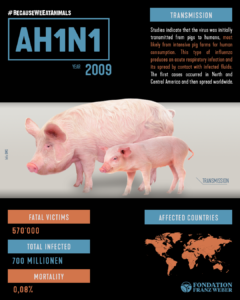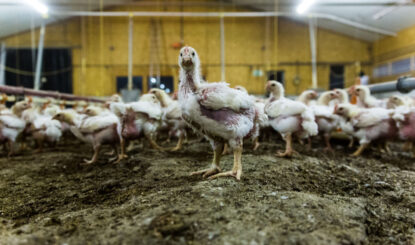#BecauseWeEatAnimals: AH1N1, the influenza virus
A previously unknown subtype of the H1N1 virus spread rapidly worldwide in 2009 after initial outbreaks in North and Central America. The virus had been transmitted to humans from pigs kept in factory farms. New estimates suggest that more than half a million people have fallen victim to the virus, with 80% of the dead under the age of 65 – which is completely atypical for this type of virus.

Origin: AH1N1 is a zoonotic disease, meaning that it is transmitted from animals to humans. The data indicates that the virus was transmitted from pigs to humans (Trovão and Nelson, 2020).
Country: Mexico was the first country to report cases, later spreading to the United States and Canada. (WHO).
Year: 2009
Fatality: 575,000 deaths. There are no exact figures, as symptoms may be confused with other diseases. However, a study conducted by the CDC and LED (2012) concluded that around 395,600 people died as a result of respiratory causes, and up to 179,900 people passed away from cardiovascular difficulties, both caused by the virus (CDC).
Symptoms: Two to three days after infection, sufferers experience sore throat, a dry cough, headache, rhinitis, muscle pain and fatigue.
Social and economic implications:
The swift global spread of influenza AH1N1 put the health systems of several highly developed nations to the test, in contrast to most infectious diseases such as NIPAH, ebola or cholera, which thrive in extremely poor environments. For example, the virus outbreak in England prompted two huge waves of admissions in 170 hospitals up and down the country between 2009 and 2011. This incurred admission costs of nearly 46 million pounds sterling, which a priori were destined for other segments in British social policy (Delivorias and Scholz, 2020).
Mexico’s economy recorded losses of US$ 1.1 billion in the tourist sector (approximately 10 % of income from international tourism) Speakman and Sharpley (2012).
More information:
- Read more on our project page «Corona and other pandemics»
- A 2018 documentary from Cambridge University, titled ‘Spanish Flu: a warning from history’ in some ways seems to predict what we are experiencing today. In a little over 10 minutes, this educational video explains not only the scientific implications of viruses and pandemics, but also their devastating social and political consequences. Highly recommended. Link to the Youtube-Video


